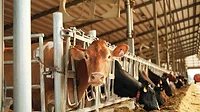Company News
Enzymit Partners with Aleph Farms to Market Cultivated Meat

Image courtesy of Aleph Farms
Enzymit announced the development of insulin substituents in partnership with food technology company Aleph Farms that are intended to reduce the cost and development time for producing cultivated meat at scale.
One of the most prohibitive expenses in scaling up cultivated meat production is developing non-animal-derived serum protein mimetics that promote and support cell growth. Such proteins are not widely available in the current market at the quantity, quality and cost necessary for large-scale production. Aleph Farms turned to Enzymit to co-develop novel insulin substituents in microorganisms that can fulfill the function of proteins found naturally in animals with greater desired activity per molecule.
"Developing more suitable processing aids for the production of cultivated meat is imperative for driving economies of scale and taking cultivated meat mainstream,” says Neta Lavon, Ph.D., CTO of Aleph Farms. "This innovation is helping to build the foundations for our sector to achieve cost-efficiency and long-term impact.”
As insulin is a highly conserved protein across mammals and other species, it has the potential to similarly influence the production of other cultivated meat types, such as porcine, ovine and poultry.
“Aleph Farms has been an invaluable partner for this initiative, which can pave the way for more cost-efficient production of cultivated meat,” says Gideon Lapidoth, Ph.D., CEO of Enzymit. “With recombinant proteins currently accounting for the overwhelming majority of cell culture costs, creating highly stable and more active insulin substituents can markedly reduce the cost of growth media and increase efficiency in producing cultivated meat at scale.”
Utilizing its computational design algorithms and testing capabilities, Enzymit says it was able to develop a variety of insulin substituents and experimentally assess their functionality. All those selected were soluble proteins expressed in E. coli and purified without requiring refolding, complex purification steps or other treatments. Further screening resulted in several leading candidates exhibiting superior results in activity for cell culturing and requiring minimal concentration for activation. These new proteins, which demand fewer downstream purification and maturation processes, are expected to reduce production time and costs.
Looking for a reprint of this article?
From high-res PDFs to custom plaques, order your copy today!







